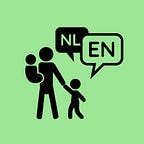Language development: Preverbal stage (0–1 years)
In this blogseries I will talk about the language development or acquisition of a child, both monolingual and bilingual (or multilingual). Before I dive into this first stage, I made an introductory blogpost about the different stages I will mention and the most used defining terms. If at any stage you don’t understand the abbreviations used, go check them out here!
I normally divide my post in three sections, one for monolingual development (MFLA), one for simultaneous bilingual development (BFLA) and one for sequential bilingual development (ESLA).
In this post I will talk about the preverbal stage, that usually last from (before) birth until the 1-year mark. As the name suggests, this is the period of language development “before speech”. As for this stage there are almost no differences between monolingual and simultaneous bilingual development, I will discuss these two together.
Broadly speaking, babies develop their receptive language (understanding) first and their productive language (speaking or signing) later. This is why even though babies don’t speak themselves, it is very important to talk to your baby and stimulate the basics of communication and their understanding of the world around them.
Babies are able to hear and process spoken language very early, starting at about the 25th week of pregnancy. From birth to 6 weeks, babies are able to recognise voices and identify their parents by their sound. As they don’t know yet what communication and language is, they don’t understand what is being said, only that people are making sounds. Their own main sound at this age is crying, which is very much communication but not yet conscious.
Between 6 weeks and 4 months, a baby learns more and more about social connection and will often show their first social smile. Parent and baby can have attention for each other and the baby will start to vocalise. This means they are making different noises (often only vowels). Babies will also be able to hear differences between vowels in short words, such as “bell”, “ball” or “bill”.
Between 4 and 7 months, babies become more focused on speech and are able to interact more and more with their surroundings, and particularly parents. Even though quite egocentric, they are starting to have “fake conversations” and can be introduced to back and forth “talking” and playing. They are able to hear differences between consonants, starting with the most common ones in each of their languages. Their own sounds look more and more like babbling (bababa, mamama, popopo etc) and is not yet language specific.
Starting from 7 or 8 months, babies really start to interact consciously and also understand words. Whereas at first they only developed their listening skills and could differentiate between sounds, they now start to attach meaning to those sounds. From this stage on, they become more and more sensitive to differences in sounds and words in their native language(s). Information about languages the baby doesn’t hear, will now get filtered out their system. The babbling of the babies will vary more and more and will also sound more and more like their native language(s). Eventually and slowly these babbling or gibberish sounds will change into intentional first words around the age of 12 months.
On this topic, I can be very brief. The definition of sequential bilingualism, or second language acquisition, is that children first develop their first language(s). As this hasn’t happened yet, there is no such thing as second language acquisition before the age of 1 year old. Many researchers even use the 3 year mark as the start of second language acquisition. Any languages that are being developed before this stage, is considered to be a first language. More on this topic can be found here.
When children are introduced to a new language in a later stage, they use the knowledge they already have acquired from their first language(s). This means that the preverbal stage will be skipped for languages 2, 3 etc. A child who can already speak in language 1, will not suddenly revert to babbling in language 2. They will most likely have a silent period, and then start talking in that language. You can read more about this in the next posts about the other developmental stages.
Originally published at https://intentionallybilingual.weebly.com.
